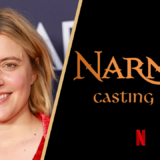NarniaWeb Set Report #3: Locations
Read Set Report #1
Read Set Report #2
Other Set Reports: ComingSoon.net, Scifi.com, IESB.net, UGO.com, IGN.com
Exclusive: Prince Caspian Set Report #3 – Locations
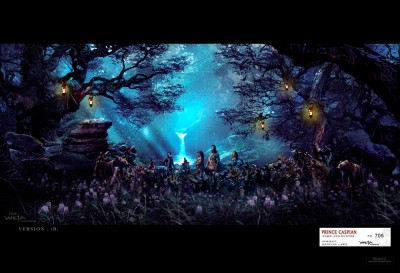 By GlumPuddle
By GlumPuddle
We pulled into Barrandov Studios on a cloudy morning at approximately 9:00am on Monday June 4, 2007. As we drove in, I looked inside one of the stages and got a glimpse of some artificial trees. I think that’s when it started to sink in that this wasn’t another dream. I was only minutes away from stepping into Narnia. In my dreams, I was alert, excited, trying to take in all the details. When the time really came, I was quiet and almost shaking with nervousness. I had triple-checked everything:
Notepads and pens. Check.
Waterbottle. Check.
Micro-cassette recorder. Check.
Extra tapes. Check.
Extra batteries. Check.
Extra micro-cassette recorder (hey, you never know). Check.
Paperback copy of Prince Caspian. Check.
I stepped out of the van and shook Ernie Malik’s hand. Ernie is the film’s publicist and is in the process of writing a behind-the-scenes book on the Prince Caspian film. He was our guide through Narnia, and also did a fantastic job arranging interviews with the cast and crew. We got our badges and then he started leading us to the first set. The other writers were talking, but I was looking around, hoping to see some sign of Narnia. For awhile, there was little to be seen but the outside of the soundstages, where I knew the sets must be. Then I caught a glimpse of a full-size lion sculpture. It’s funny looking back on that now, because it felt like a really big moment — but that was just the tip of the iceberg, of course.
We turned left, and I saw that Ernie was leading us to the soundstage where I had seen the artificial trees when we drove in. The moment had come at last. One of the Disney guys smiled and asked me, “Are you ready?” It was a valid question, to be honest. Was I really ready for this? I smiled back and said, “No, I’m not sure I am.” I took a deep breath. Ready or not, I stepped through the door (leaving it open behind me, of course)… and into Narnia…
THE DANCING LAWN (Stage 8)
My first thought (after getting over the initial shock, of course) was that the brown cliff on our right was the exterior of Aslan’s How. But I soon found I was mistaken. There were trees (real and fake) around it with a small clearing in the middle. Everything had a rather damp look. The space was surprisingly small for a forest, but a detailed painting of the background circled the set. I reached over and grabbed a small handful of dirt just to see if it was real (it was, as far as I could tell). The set was clearly under construction. Many of the trees needed work, and the concrete floor was still visible. The crew was in the process of converting the set from a different location in the story…
“This is called the Dancing Lawn,” Ernie said, and I quickly scratched out my first note that it was Aslan’s How. “This is where Caspian, Nikabrik, and some of the other Narnians are talking about how to mount an offensive against Miraz. This is a set that is being re-designed. We already shot a scene here where the four kids have saved Trumpkin, and then they gather around a campfire — probably the beginning of Chapter 4 of the book. And then, Trumpkin proceeds over the next four chapters to narrate what has happened to Narnia over the past 1300 years. The kids disappear, I mean when you read the book, the kids are basically just sitting there listening to the story. If we had adapted the book faithfully the way it is, it wouldn’t be that cinematic. It’s not a very cinematic story.
“They go into the woods and they have a campfire, and then Lucy wakes up and she thinks she hears a voice. And it’s Aslan calling from somewhere. And then she gets up. And we shoot part of that here, and then we cut to the location in New Zealand, and then cut to the location in Poland. So it’s basically three woods — one soundstage, two real areas — that will portray one area in the story.” When I heard that this memorable scene from the book would be in the film, I wanted to shout my joy to the world! It’s a good thing I brought a tape recorder because it was hard to concentrate on the rest of what Ernie said. That’s when I realized that I would have to just focus on getting the story now, and get emotional later.
“The woods that they found just a kilometer over the Czech border are unbelievable,” Ernie continued. “These rock formations are basically photographs and renditions of what really exists in eastern Czech Republic and western Poland. They’re surreal. It’s amazing how mother-nature sculpted these things. This location is pretty high up, easily one thousand feet above sea level where we shot in Poland, but at one point you have to ask yourself ‘was this underwater?'”
The advantage of an interior set is that the crew doesn’t have to worry about weather, and it is a much more controlled environment. “If you build something and make it work in an interior, you certainly try to do that,” Ernie said. “This whole area right here was all grass. And we water it, it’s living. It’s a living breathing forest. And when you create a forest, along with that come insects.”
STABLES (Stage 7)
Our next stop wasn’t far away. When I walked in, I was not able to guess where we were, because there was more construction going on here than in the Dancing Lawn. It was all wood that was still waiting to be painted, and I couldn’t guess what shape it would eventually be. Ernie said that these were the Telmarine stables, and that weeks before, a set called “The Great Hall” had been here.
“[The Great Hall] is where Miraz has his coronation and they put the crown on his head,” Ernie said. “There are 20 lords in the scene plus Miraz. Four of them have dialogue, the rest are just extras. The thrones that they manufactured for the scene are fabulous. It was all done by Kerrie Brown, our set decorator who was worked for Roger Ford for 15 years. They’ve done 11 movies together.”
Ernie then gave us a little summary of the rest of the shooting schedule: “We go back and forth. We’re out in northwest Czech Republic right now, we’re there all this week. We’re supposed to be back here shooting next Monday for the next three weeks. Then we go to Slovenia, that’s going to be the river-god sequence, which is a big climactic scene in the book. That bridge is being built. They’ve had to re-route the flow of a river to do that, with the approval of the Slovenian government. Then we go back to Usti and do the battle, and then we come back here and finish up. We finish sometime in August.”
“When we did the first movie,” Ernie continued, “We had eight soundstages in Auckland, New Zealand. Basically they were warehouses, sheds. So when it rains… that’s always good for sound (laughter). That could very well be why Tony Johnson got nominated for Sound Mixing on the first movie, because he managed to mix all of that stuff out. We shot that in winter, and winter in Auckland is rain.” On the first film, they didn’t do much exterior shooting. They had a few shots in real snow, the White Witch’s Camp, Aslan’s Camp, and the battle, but the rest of the film was mostly done on sound stages. “This is the opposite,” Ernie said. “We have one-third interior soundstages, two-thirds exteriors. And shooting exteriors, no matter where you are on the planet, means you have to deal with weather.”
ASLAN’S HOW: THE CISTERN (Stage 6)
Ernie led us over into the very next room. When we walked in, I didn’t immediately think “Aslan’s How” because C. S. Lewis describes the How as a place where Giant Wimbleweather wouldn’t be able to fit. This immense round room was made of gray stone (or so it appeared). I asked Ernie how high the ceiling was, and he said over 60 feet! At the far end, a few steps went up to a huge doorway that led to — well, nowhere. But in the finished film, it will lead into the Stone Table room. They finished shooting the Stone Table on April 23, and were in the process of converting this set to what Ernie called “the Cistern,” which leads into the Stone Table room.
When we interviewed William Moseley (Peter) later that day, I asked him what his favorite set in this film was, and he said it was the Stone Table room. We didn’t get to see it, but Ernie described it for us:
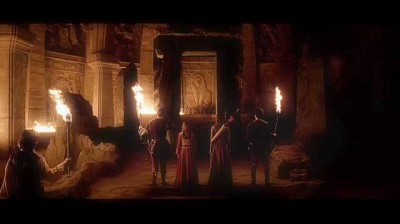 “What we had in here to start with was Aslan’s How and the Stone Table cracked 1300 years after Aslan had been crucified on it. And it was a much smaller cavern. If you remember the first movie, the Stone Table was an exterior. And what the Narnians did over 1300 years was… this became sort of a shrine, and they entombed it. And on the walls, Andrew and Roger Ford decided to put these carvings that sort of told stories of what happened to Narnia during the 1300 years. I equate it to what they did in the first film with the wardrobe. The wardrobe that supposedly inspired Lewis’ writing is just a blank piece of wood. And, if you remember the first movie, there were carvings on it, and it was alluding to The Magician’s Nephew, the prequel to The Lion, the Witch and the Wardrobe. So these carvings, the one that is just incredible is the one of Aslan. Truly an incredible set. But, this is sort of leading into the room where the Stone Table is, so we’re calling this ‘Aslan’s How: the Cistern.'”
“What we had in here to start with was Aslan’s How and the Stone Table cracked 1300 years after Aslan had been crucified on it. And it was a much smaller cavern. If you remember the first movie, the Stone Table was an exterior. And what the Narnians did over 1300 years was… this became sort of a shrine, and they entombed it. And on the walls, Andrew and Roger Ford decided to put these carvings that sort of told stories of what happened to Narnia during the 1300 years. I equate it to what they did in the first film with the wardrobe. The wardrobe that supposedly inspired Lewis’ writing is just a blank piece of wood. And, if you remember the first movie, there were carvings on it, and it was alluding to The Magician’s Nephew, the prequel to The Lion, the Witch and the Wardrobe. So these carvings, the one that is just incredible is the one of Aslan. Truly an incredible set. But, this is sort of leading into the room where the Stone Table is, so we’re calling this ‘Aslan’s How: the Cistern.'”
The tunnels inside were a perfect maze till you got to know them, and they were lined and roofed with smooth stones, and on the stones, peering in the twilight, Caspian saw strange characters and snaky patterns, and pictures in which the form of a Lion was repeated again and again. It all seemed to belong to an even older Narnia than the Narnia of which his nurse had told him. — Prince Caspian, Ch. 7
TELMARINE COURTYARD
The funny thing about Barrandov (and probably most studios) is that the outside of the soundstages don’t look like anything special; you would never know that Narnia was inside them. As Ernie led us to our next set, we walked on a temporary sidewalk made of wood planks to avoid the puddles. I stepped through a small doorway that led into a long skinny hallway (I had to duck). As I looked ahead, I could see some pretty good-sized stone pillars. “Cool!” I thought. But when I reached the end of the wooden hallway, I saw that was only a fraction of the set. I looked up and gasped. As the other writers entered, they also gasped (I’m not exaggerating any of this). It really took me several seconds to take it in…
We were standing in an enormous outdoor 360-degree castle courtyard! After the initial shock, all the writers were stunned into silence as we took in the details. The color was mainly light brown and there were stone balconies and steps all around. At the far end, I saw what looked like a stained glass window. Ernie explained that that window was supposed to be the exterior of the great hall. I noticed a compass and an eagle carved in a few places (Roger Ford explained this when we interviewed him). I think this picture might be a portion of the courtyard, but I’m not certain.
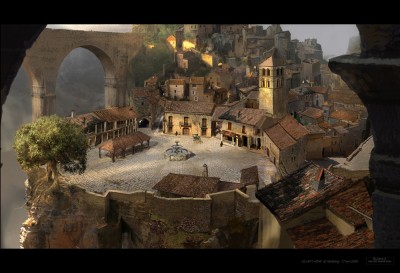 But that wasn’t all! The set continued on to another section, which led out to a drawbridge, which led to the beginning of the Telmarine town (the rest of the town will be a miniature). Ernie said they will use forced perspective to make the bridge seem longer. It was all one giant connecting set! It took 200 men and 15 weeks to build, and Ernie said it’s probably the biggest set Roger Ford has done in his 40-year career. Here is a quick drawing I did, just to give you a sense of where everything is.
But that wasn’t all! The set continued on to another section, which led out to a drawbridge, which led to the beginning of the Telmarine town (the rest of the town will be a miniature). Ernie said they will use forced perspective to make the bridge seem longer. It was all one giant connecting set! It took 200 men and 15 weeks to build, and Ernie said it’s probably the biggest set Roger Ford has done in his 40-year career. Here is a quick drawing I did, just to give you a sense of where everything is.
When we talked to Richard Taylor (Head of Weta Workship) later that day, he said they had been working on the miniature of the castle, but he wouldn’t actually see the full-size set until the next day. “It’s very odd being a miniature builder because you myopically focus on things,” he said. “Even if you’re building a miniature as big as this room, everything you build you build on a table at scale, you bring all of the pieces together and throw into a huge miniature. It’s going to be bizarre tomorrow, having focused on the colors and tomorrow I will be walking through it.” Richard said that the miniature of the Telmarine castle and town was as big as the tent we were in. I would estimate that the tent was 80×130 feet! No wonder they call them big-atures! Weta Workshop made some enormous “big-atures” for The Lord of the Rings and King Kong, but Taylor said this one would outdo them all. “It is so exciting and so challenging and on a monumental scale,” Taylor said. “I can’t wait to get it in front of the camera. We’re very fortunate that directors like Andrew still celebrate in the tradition of model-making.”
One of the major sequences in the film does not appear in the book: the Night Raid. Ernie said this scene takes place about halfway through the story, after the Pevensies have met Caspian. Ernie pointed up to a balcony, telling us that it led to Miraz’s room. During the battle, Miraz and Glozelle come out, and Glozelle shoots a faun trying to climb up to them. It took them five weeks to shoot the scene. William Moseley (Peter) also did a big horse stunt (more on that in an upcoming report). Ernie said that the three eldest Pevensies fight, but Lucy does not.
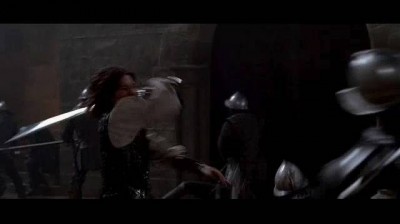 Ernie talked more about the conflict between the characters that we’ve been hearing about. “You have this animosity between a prince who is the rightful heir to the throne and somebody who is a king,” Ernie said. “And of course the king feels that he trumps the prince, because this used to be Peter’s throne. All four of them were the high kings and queens of Narnia. So you have that animosity that exists between those two characters. They decide to lay siege on the castle to take Miraz down. They don’t understand that there are other ways of doing it.”
Ernie talked more about the conflict between the characters that we’ve been hearing about. “You have this animosity between a prince who is the rightful heir to the throne and somebody who is a king,” Ernie said. “And of course the king feels that he trumps the prince, because this used to be Peter’s throne. All four of them were the high kings and queens of Narnia. So you have that animosity that exists between those two characters. They decide to lay siege on the castle to take Miraz down. They don’t understand that there are other ways of doing it.”
This was definitely the most impressive set I saw, simply because it didn’t feel at all like a set. It was 360 degrees, so you could turn all around and it still looked completely believable. And the scale was incredible. It’s rather heartbreaking to think it has probably been torn down by now. As we finished our interview with Roger Ford, I asked one of the other writers, “Help me out here, this is my first set visit. Do all movies have a set like this, or is this really special?” She shook her head and said it was the biggest set she’d ever seen, and this was certainly not her first set visit.
ASLAN’S HOW EXTERIOR
It was certainly an awesome place, a round green hill on top of another hill, long since grown over with trees, and one little, low doorway leading into it. — Prince Caspian, Ch. 7
Although the Telmarine Courtyard was the most impressive set, the most exciting set for me personally was the exterior of Aslan’s How in Usti, because it’s a location from the book, and I actually got to stand at the very place where Peter and Miraz will duel!
We walked past the opposite side of the Aslan’s How set, but I didn’t realize this because it was just scaffolding. I didn’t even really give it much thought until we circled around and I saw that it was Aslan’s How. I believe Ernie said that there will be two entrances to the How in the film, and they will use this set for both. Aslan’s How is a little different from what Lewis describes in the book and what Pauline Baynes depicts in her illustrations. Instead of a round green hill, the How seems to be made of gray blocks of stone. One thing I noticed about the way it was constructed is that you could see the logic of how the Narnians built it. “That was all constructed by the Narnians to hide the Stone Table,” Ernie said. The path leading into the How sloped down into the entrance. So when Peter and Edmund first emerge, the cheering Narnians are actually above them for awhile.
The structure I saw was in the middle of a huge clearing and stood about 60 feet high. It seems there will be different “levels” to the How. The bottom had a huge rectangular entrance, which must have been at least 20 feet high. The second level had three openings: one on the left, one in the middle, and one on the right (Ernie had seen them place cameras on the second level, but had yet to see characters up there). All I saw of the third level was a blue screen. Andrew Adamson told us that in the final film, the How will appear about 2 1/2 times higher. The whole thing was overgrown with trees and other plants sticking out of the cracks between the rocks. Ernie hadn’t seen any concept art of this location, so he wasn’t sure what it would look like in the finished film.
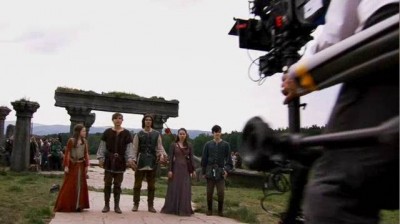 Something the filmmakers have added to the story is the ruin of a temple about 50 yards from the How. This is where the single combat between Peter and Miraz will take place in the film, instead of the boxing ring setting in the book. The ruin looks like a cross between Stonehenge and the Stone Table set from the first film. In this picture, Caspian and the Pevensies are facing Aslan’s How, and you can see the path and the ruins in the background. When we interviewed him, Roger Ford talked about their reasons for adding the ruin to the story.
Something the filmmakers have added to the story is the ruin of a temple about 50 yards from the How. This is where the single combat between Peter and Miraz will take place in the film, instead of the boxing ring setting in the book. The ruin looks like a cross between Stonehenge and the Stone Table set from the first film. In this picture, Caspian and the Pevensies are facing Aslan’s How, and you can see the path and the ruins in the background. When we interviewed him, Roger Ford talked about their reasons for adding the ruin to the story.
When we came back the next day, they were filming a scene where Peter and Edmund emerge from Aslan’s How. The grass was a big concern. I guess they can’t have the grass looking like it has been trampled by a film crew. So everyone had to stay on the stone path. Before one of the takes, a few of the writers (including myself) stepped away from the path a little to get a better look, and we had the honor of being called “grass-killers!” by K.C., First Assistant Director.
UNDERGROUND TUNNELS
It took us about two hours to get to our last stop, Modranská Studios, where we interviewed Howard Berger and Dean Wright. We were told that if we had arrived sooner, we would have seen them filming a very complicated sequence for the battle.
This set is difficult to describe because there was so much blue screen, and it was really hard to get a sense of what it was going to look like in the finished film. But the set was supposed to be tunnels beneath Aslan’s How. There was so much noise that we could barely hear one another. I would estimate that the ceiling was over 10 feet high. The color of the rock was mainly brown, and several stone pillars had been constructed. The funny thing was that only half of each pillar had been built. When I walked in and saw them, they looked real. Then when I walked around, I saw that the opposite side of each pillar was flat and without detail. Maybe that side won’t be seen in the film.
We walked across the street and found the exact same set, only smaller. This set was built to make the actor playing Wimbleweather look bigger. For some reason, this set was elevated fairly high off the ground.
Read our interviews with Roger Ford and Richard Taylor!
View all 7 new pictures in the Image Gallery!
I think one of the most exciting things about adaptations is getting to see a world from your imagination become real on screen. But getting to actually visit the sets with this level of detail made it feel like Narnia was real, and I was in it! I look forward to seeing this world come to life on screen!
Three reports down, two to go!



